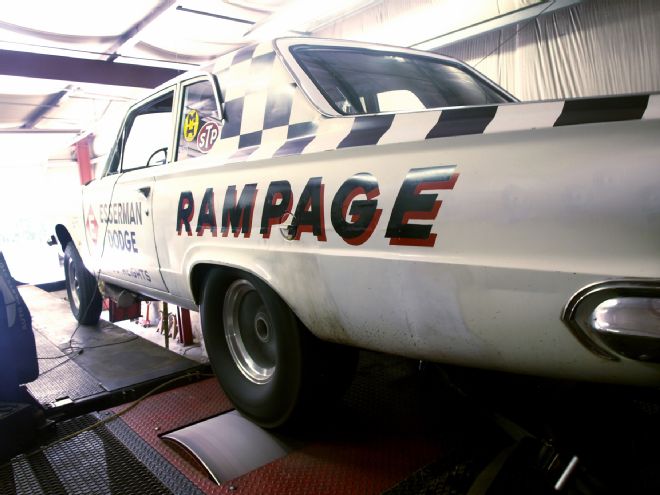
Chrysler Corp. upstaged GM, Ford, and AMC with the unveiling of the U.S. auto industry's first mass-produced, magnetic-trigger, breaker-less electronic ignition system in 1972, a full three model years ahead of the nearest competitor. Finally, the decades-old hassle of setting point gaps was over—at least for buyers of 1972 Chrysler Corporation vehicles who paid an extra $35 for the optional N23 electronic ignition system (it was standard on all 1972 Mopar muscle cars powered by the 340, 400 4-bbl, 440 4-bbl, and 440 Six Pack—yep, a handful were built early in the year).
Things got even better for 1973 when the N23 electronic ignition system went from optional to standard equipment on every Chrysler engine, from the lowly 198 Slant Six to the 440 Magnum, as a no-extra-charge standard feature. So while drivers of factory-fresh 1973 Chevelle SS454s, 351 H.O. Mach 1s, Olds W-30 4-4-2s, and everything beneath them continued to hassle with burnt points, high-rpm point bounce, worn distributor cam lobes, fouled spark plugs, and inferior spark intensity, Mopar drivers made daily use of race-proven, solid-state technology and enjoyed a newfound ability to start their engines on the first flick of the key.
And while the new electronic ignition system eliminated the hassle of points, it signaled the dawn of the age of computer-controlled engines, from which there would be no turning back. Housed within a compact, weatherproof metal box that Chrysler called the electronic control unit (ECU) were solid-state electronic circuits, potted within a flexible, rubber-like bed. The electronics took the tiny magnetic pulse created in the distributor as the reluctor passed the pickup and amplified it via a switching transistor to charge the coil and fire the plugs. It was simple, effective, and reliable.
Mopar owners of a certain age are well familiar with the nifty electronic ignition conversion kit released as early as 1975 for owners of pre-1972 single- and dual-point-equipped Mopar muscle machinery. Consisting of a new breaker-less distributor with a performance-oriented curve and adjustable vacuum advance, matched ballast resistor, wiring harness, instructions, and ECU, these popular Mopar Performance kits were—and continue to be—offered for Slant Six (P3690789), small-block (P3690426), and big-block applications (low-deck, 350–400, big-block V8; P3690427, raised-deck, 413–440 big-block/426 Hemi V8; P3690428).
The standard ECU included with the time-tested Mopar Performance kit is the so-called Orange Box (P4120505) and is great for general performance up to 6,000 rpm. For more aggressive engine packages with higher rpm ceilings, Mopar Performance offers the Chrome Box (P4120534), good to 8,000 rpm. Though it is currently missing from the Mopar Performance catalog, nobody can forget the Super Gold Box (P4120600), which was good to 12,000 rpm and came with a warning not to use it for street driving because it was prone to overheating and failure. This trio of ECUs introduced Mopar fans to the world of plug-and-play performance improvements and were an excellent complement to the electronic ignition conversion kit. In fact, take a walk around virtually any Mopar car show from 1980 onward and you'll see the telltale orange, chrome, or gold ECU bolted to the firewall or inner fender apron, a sure sign the original point-type ignition is long gone.
But as good as these components are, none of the electronic control units—Orange, Chrome, or Super Gold (or any aftermarket unit we've ever seen, for that matter)—can control runaway engine speed. If you want a rev limiter to protect your engine from damage caused by missed shifts, driveline breakage, or deteriorating track conditions, you'll need to choose between an electronic piggyback unit or an old-school mechanical tachometer/distributor combo with a cable-driven, rev-control function—until now.
With the advent of the new Rev-N-Nator ECU from R/T Garage, you get a built-in rev limiter, LED tachometer function, and claims of as much as 10 to 40 additional horsepower over other ECUs. Better still, it's a quick plug-in upgrade, looks stock, and even uses the same mounting holes as the original unit. To explore this revolutionary new offering, we tested it on the author's Rampage altered-wheelbase Match Bash 1963 Dart. Regular Car Craft readers will remember this car as a mule for a series of Mopar big-block engine and rear-axle stories going back as far as 2007. Let's put the Rev-N-Nator on the Dynojet chassis dyno at R.A.D. Automotive Machine and see what it's made of.
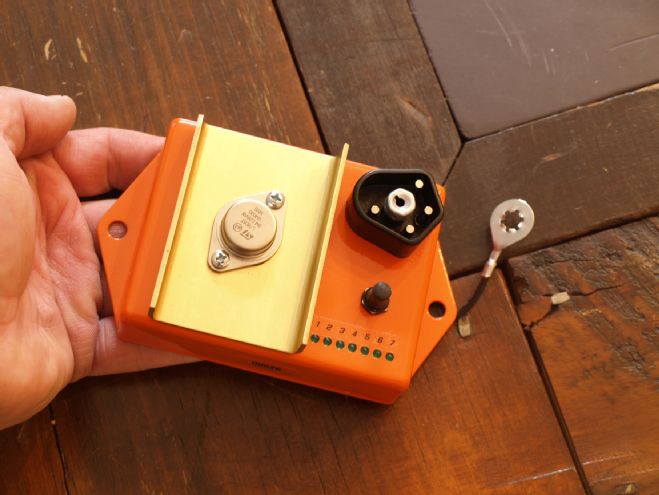
The Rev-N-Nator is visually similar to traditional ECUs, except for the row of seven LED lenses, the weatherproof pushbutton set switch, and external ground wire. Pushing the button repeatedly sets the rpm limit point at 3,000, 5,000, 5,500, 6,000, 6,500, 7,000 or 7,500 rpm. We double-checked the accuracy of the limit function against the dash-mounted Sun tach and found it to be within 200 rpm of its claimed activation point. The 7,000- and 7,500-rpm limits remain untested because the test car's cross-rammed 512 can't spin that high. The LEDs illuminate whenever the engine is running and show crank speed in 1,000-rpm increments.
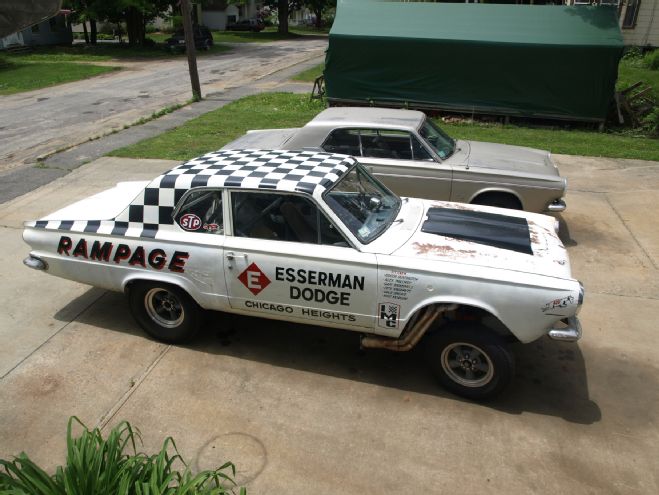
The backside is potted with a pliable, rubber-like material to protect the electronics from moisture and vibration. The ground wire is unique to the Rev-N-Nator. R/T Garage says the electronics are superior to factory items and that 10 to 40 extra horsepower are typically unleashed after ignition timing is retarded a few degrees to accommodate the Rev-N-Nator's characteristics.

The Rev-N-Nator is supplied with easy-to-understand instructions. The use of vacuum advance is discouraged, as are stock coils and ignition wires. The Rampage's coil is an MSD Blaster II that's been painted black. It's teamed with Mopar Performance 7.5mm wires.

We joke that the Rampage "shines from the inside out." The raw patina is intentional and adds to its functionality. Thanks to the excellent traction afforded by the altered-wheelbase surgery, it's a great testbed for engine and driveline parts intended for drag-race use and general street cruising. The original Rampage was an exhibition match racer campaigned around Chicago by Jack Sharkey back in the 1964–1966 period. This loose tribute was built in 2007 and is completely streetable, but the lack of certain NHRA-mandated safety items prevent dragstrip action thus far. Seatbelts, external battery cut-off, long wheel studs, and so on are coming soon.
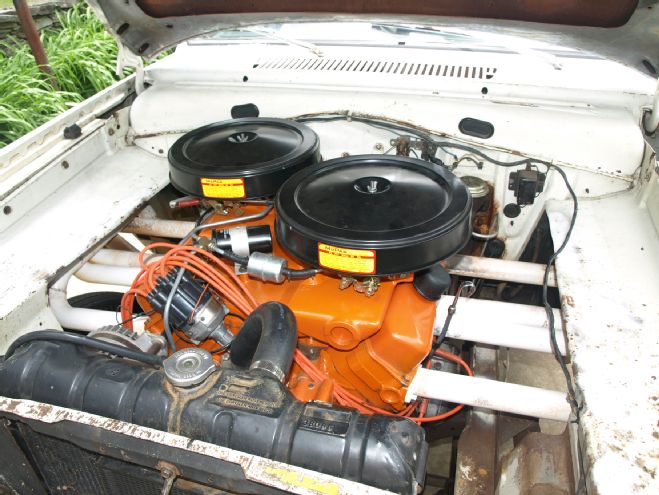
The Rampage tribute started out with a budget-built, cast-crank 440 from a Winnebago motorhome, but has been through a few transformations over the last seven years. The present specs are: 512ci stroker from 440 Source with 10:1 pistons, 440 Source aluminum heads, Isky Mega 292 flat-tappet hydraulic cam, A&A 440-port cross-ram intake with dual Edelbrock 750-cfm carbs, and stock Chrysler electronic distributor with Orange box. Note the handmade vacuum-advance canister block-off plate on the distributor housing. The internal advance plate and arm assembly were centered and locked down with a spot-weld.
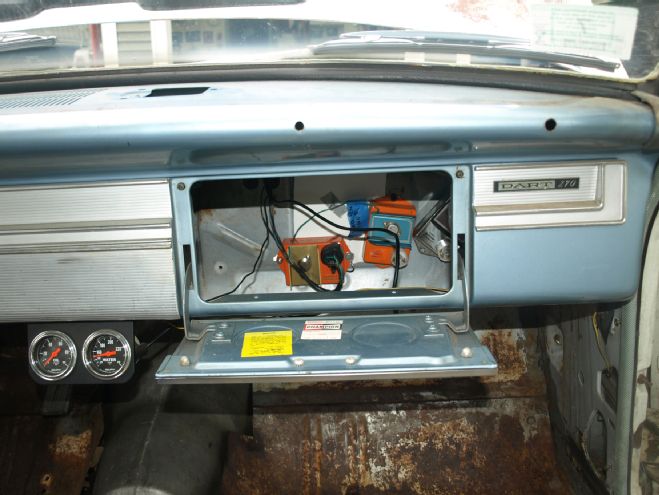
Like the original match bashers, the Rampage is gutted of all excess weight. The stock heater unit and cardboard glovebox were eliminated along with the carpeting, headliner, and bench seating. For easy access during comparison testing, the trio of ECUs are accessed through the glovebox door. Yes, that's the top of the 727 Torqueflite case visible under the gauges. The stock first-gen A-body trans tunnel was designed for the smaller A904 Torqueflite, so the floor was sliced for clearance. A suitable transmission tunnel patch will eventually be fabricated. An A&A bolt-in sprag assembly boosts the safety factor until the floor is finished.
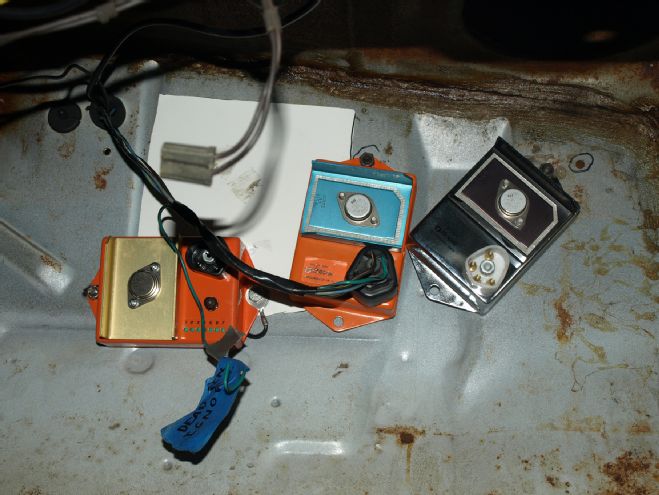
All three ECUs were mounted close together so we could jump between them quickly during the test. The contenders are (left to right) the Rev-N-Nator (PN OR #526), MP Orange box (P4120505), and MP Chrome box (P4120534). The Rev-N-Nator is the only unit requiring an external ground wire. Note the correct ground-wire orientation with the lead (supplied) pinched between the mounting ear and bolt head. The LED tachometer displays engine rpm in 1,000-rpm increments as each "bulb" illuminates. Clearly, the LED tachometer feature is of no use with the Rev-N-Nator mounted here. But when bolted underhood, to the firewall or inner fender, ignition-timing adjustments are greatly aided by reading the LED display. Without it, you'd need a partner inside the car to shout out rpm as you turn the distributor body.
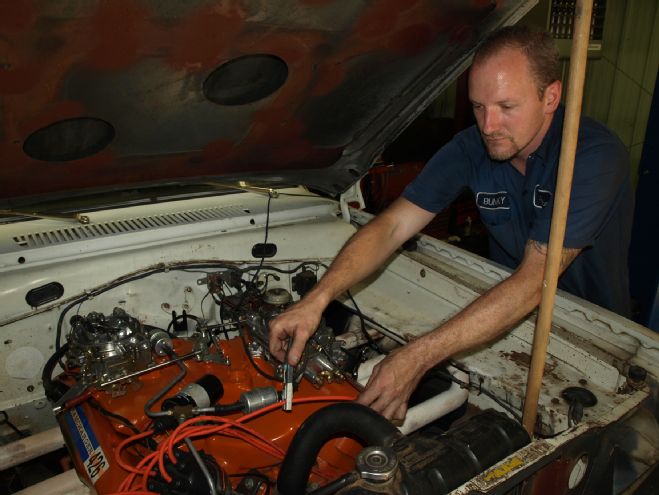
All chassis-dyno operation was performed at R.A.D. Auto Machine by Bunky Amelotte on one of the hottest days ever recorded in the month of September in Massachusetts. Ambient temperature of nearly 100 degrees, plus nearly unbearable humidity, limited our testing. With the distributor set to deliver 35 degrees BTDC at 3,000 rpm, the Orange box delivered 343.24 hp and 370.79 lb-ft to the tires. All runs were made with the Torqueflite in Drive and Bunky flooring the gas pedal at 3000 rpm—and holding it there until the test concluded at 6,000 rpm.
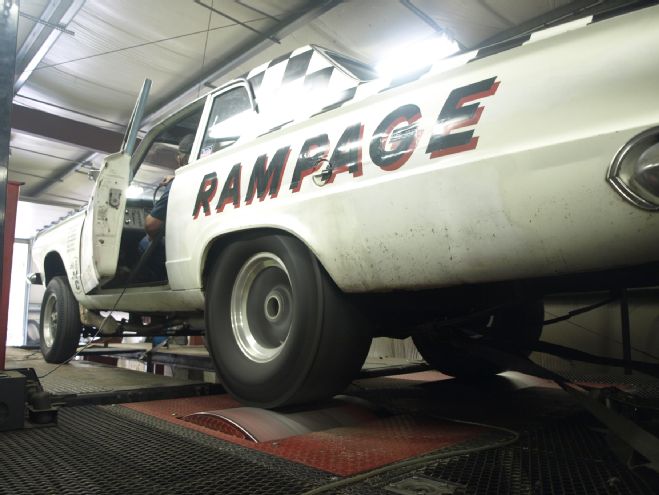
With no other changes at all, we unplugged the MP Orange box and switched to the MP Chrome box. Coolant temperature remained steady at 195 degrees and we got 344.17 hp and 369.72 lb-ft of torque. Considering that the Chrome box's claim to fame is its ability to support ignition function a full 2,000 rpm past the Orange box's 6,000-rpm limit, the 1hp gain is no disappointment. The Rampage's 6,000-rpm ceiling simply doesn't allow the Chrome box to do its thing.
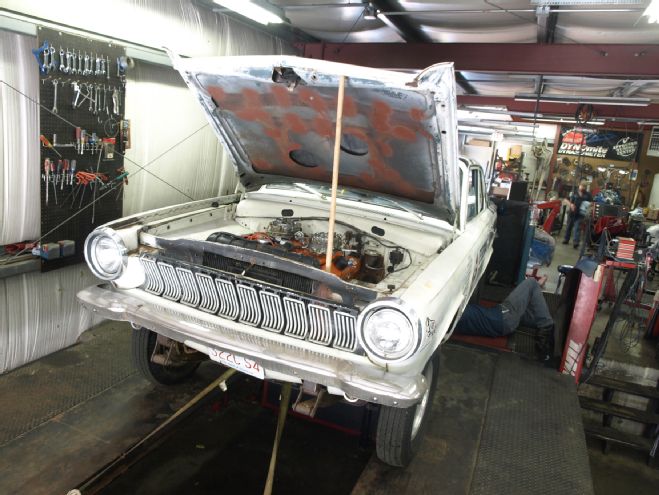
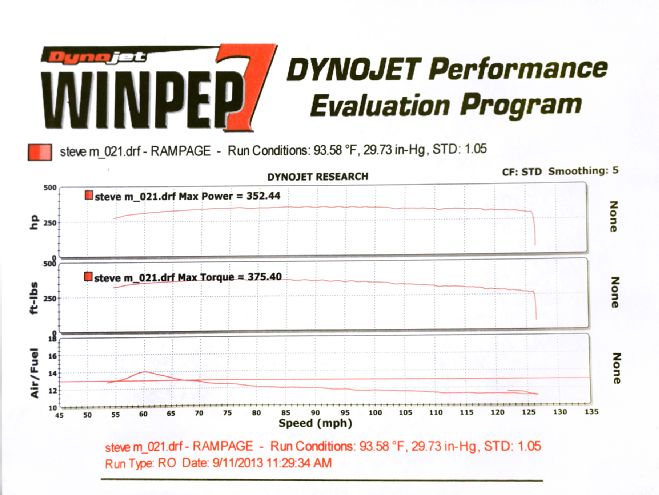
After 5 minutes to allow the Rampage's coolant temperature gauge to return to 195 degrees, the wiring-harness connection was transferred from the Chrome box to the Rev-N-Nator and 352.44 hp and 375.40 lb-ft resulted. That's 8.27 hp and 5.68 lb-ft over the Orange box with no movement of the distributor or other fiddling whatsoever. Not bad! According to the Rev-N-Nator's makers, the largest gains are had when ignition timing is reduced by 2 to 6 degrees. We can understand the potential, but would feel obligated to perform the same timing changes to the Mopar Performance Orange and Chrome boxes to be fair all the way around. In the stifling humidity of the day, it just wasn't possible. Regardless, the Rev-N-Nator has proved itself to be a worthy addition to any Mopar running a stock-style electronic ignition system. Toss in the novel rev limiter (patent pending) and LED tachometer function, and its $200 price tag is easily justified.
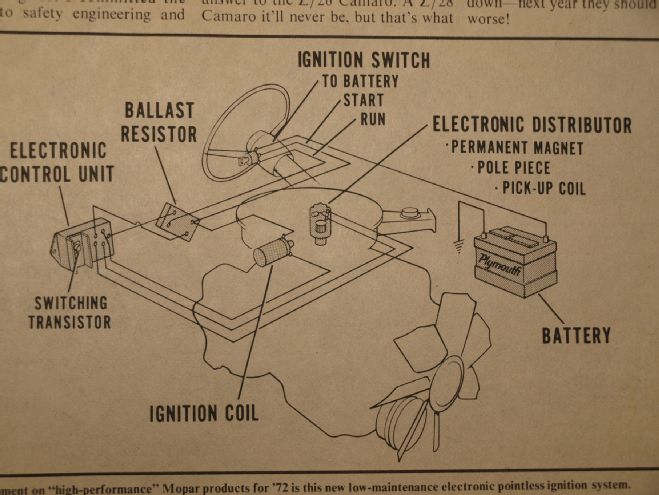
Though Chrysler's core intent was to negate increased tailpipe emissions caused by worn points and fouled plugs, performance enthusiasts were also benefactors when the point-less ignition system arrived in 1972, beating GM to the market by three full model years.